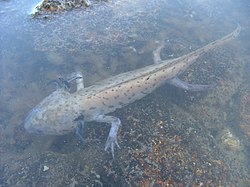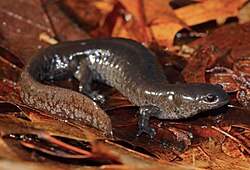| Image | Species and author | Common name | Distribution | Lifestyle | IUCN status |
|---|
 | A. altamirani Dugès, 1895 | Mountain stream salamander, Achoque | Central Mexico, west and south of the Valley of Mexico | Terrestrial and neotenic |  |
| A. amblycephalum Taylor, 1940 | Blunt-headed salamander | West-central Mexico (Michoacán state), near Morelia | Terrestrial and neotenic |  |
 | A. andersoni (Brandon and Krebs, 1984) | Anderson's salamander | West-central Mexico (Michoacán state), Laguna de Zacapu | Neotenic |  |
 | A. annulatum Cope, 1886 | Ringed salamander | South-central United States (Arkansas, Illinois, Missouri, Oklahoma), Ozark Plateau and Ouachita Mountains | Terrestrial |  |
 | A. barbouri Kraus & Petranka, 1989 | Streamside salamander | South-midwest United States (Indiana, Kentucky, Ohio, Tennessee, West Virginia) | Terrestrial |  |
| A. bishopi Pauly, Piskurek & Shaffer, 2007 | Reticulated flatwoods salamander | Southeast United States (Florida Panhandle and southernmost Georgia), west of the Apalachicola-Flint River | Terrestrial |  |
| A. bombypellum (Taylor, 1940) | Delicate-skinned salamander | Central Mexico (State of Mexico) near Jilotepec | Terrestrial |  |
 | A. californiense Gray, 1853 | California tiger salamander | Central Valley of California | Terrestrial |  |
 | A. cingulatum Cope, 1868 | Frosted flatwoods salamander | Southeast United States (southern South Carolina and Georgia south to northern Florida) | Terrestrial |  |
 | A. dumerilii (Dugès, 1870) | Lake Pátzcuaro salamander, Achoque | West-central Mexico (Michoacán state), Lake Pátzcuaro | Neotenic |  |
 | A. flavipiperatum Dixon, 1963 | Yellow-peppered salamander, Ajolote de Chapala | West-central Mexico (Jalisco) | Terrestrial |  |
 | A. gracile (Baird, 1859) | Northwestern salamander | Northwest North America (southernmost Alaska to northern California) | Terrestrial |  |
| A. granulosum Taylor, 1944 | Granular salamander, Ajolote | Central Mexico (State of Mexico) near Toluca | Terrestrial |  |
 | A. jeffersonianum (Green, 1827) | Jefferson salamander | Northeastern North America (Ontario south to Virginia and west to Illinois) | Terrestrial |  |
 | A. laterale Hallowell, 1856 | Blue-spotted salamander | Northeastern North America (Nova Scotia west to Manitoba and Minnesota and south to Indiana and New Jersey) | Terrestrial |  |
 | A. leorae Taylor, 1943 | Leora's stream salamander, Ajolote | Central Mexico (Mexico state - Puebla border), Mount Tlaloc | Terrestrial |  |
| A. lermaense (Taylor, 1940) | Lake Lerma salamander | Central Mexico (State of Mexico), Lake Lerma near Toluca | Terrestrial and neotenic |  |
 | A. mabeei Bishop, 1928 | Mabee's salamander | Coastal southeast United States (southeast Virginia to South Carolina) | Terrestrial |  |
 | A. macrodactylum Baird, 1950 | Long-toed salamander | Northwest North America (Alaska south to northern California and east to Alberta and Montana) | Terrestrial |  |
 | A. maculatum (Shaw, 1802) | Spotted salamander | Eastern North America (Nova Scotia west to Wisconsin and south to eastern Texas and Georgia) | Terrestrial |  |
 | A. mavortium Baird, 1850 | Barred tiger salamander | Western North America (Manitoba south to Texas and west to Washington and California) | Terrestrial and neotenic |  |
 | A. mexicanum (Shaw and Nodder, 1798) | Axolotl | Central Mexico (State of Mexico), Lake Xochimilco | Neotenic |  |
 | A. opacum (Gravenhorst, 1807) | Marbled salamander | Eastern United States (New Hampshire south to northern Florida and east to Missouri and Texas) | Terrestrial |  |
| A. ordinarium Taylor, 1940 | Puerto Hondo stream salamander | West-central Mexico (Michoacán state), Puerto Hondo stream | Terrestrial and neotenic |  |
 | A. rivulare Taylor, 1940 | Michoacan stream salamander | Central Mexico (western State of Mexico) | Terrestrial and neotenic |  |
 | A. rosaceum Taylor, 1941 | Tarahumara salamander | Northwest Mexico, Sierra Madre Occidental | Terrestrial and neotenic |  |
| A. silvense Webb, 2004 | Durango salamander | Northwest Mexico (Durango and Chihuahua), Sierra Madre Occidental | Terrestrial and neotenic |  |
 | A. talpoideum Holbrook, 1838 | Mole salamander | Southeast United States (Virginia west to Oklahoma and south to northern Florida) | Terrestrial and neotenic |  |
 | A. taylori Brandon, Maruska, and Rumph, 1982 | Taylor's salamander | Southeast Mexico (Puebla), Laguna Alchichica | Neotenic |  |
 | A. texanum Matthes, 1855 | Small-mouth salamander | South-central United States (Ohio west to Nebraska and south to Texas and Alabama) | Terrestrial |  |
 | A. tigrinum (Green, 1825) | Eastern tiger salamander | Eastern North America (New York northwest to Manitoba and south to Texas and northern Florida) | Terrestrial and neotenic |  |
 | A. velasci (Dugès, 1888) | Plateau tiger salamander | Mexican Plateau | Terrestrial and neotenic |  |




























